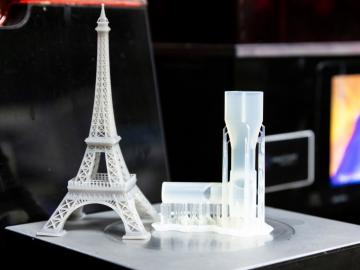
Filter News
Area of Research
- (-) Clean Energy (522)
- (-) Fusion and Fission (54)
- (-) Neutron Science (190)
- (-) Supercomputing (311)
- Advanced Manufacturing (34)
- Biological Systems (18)
- Biology and Environment (177)
- Biology and Soft Matter (5)
- Building Technologies (12)
- Chemical and Engineering Materials (4)
- Chemistry and Physics at Interfaces (11)
- Climate and Environmental Systems (14)
- Computational Biology (6)
- Computational Chemistry (5)
- Computational Engineering (5)
- Computer Science (19)
- Data (1)
- Earth Sciences (1)
- Electricity and Smart Grid (3)
- Energy Frontier Research Centers (14)
- Energy Sciences (5)
- Fossil Energy (3)
- Fuel Cycle Science and Technology (3)
- Functional Materials for Energy (16)
- Fusion Energy (17)
- Geographic Information Science and Technology (3)
- Isotope Development and Production (3)
- Isotopes (35)
- Materials (433)
- Materials Characterization (2)
- Materials for Computing (36)
- Materials Synthesis from Atoms to Systems (13)
- Materials Under Extremes (12)
- Mathematics (1)
- National Security (79)
- Neutron Data Analysis and Visualization (4)
- Nuclear Science and Technology (74)
- Nuclear Systems Modeling, Simulation and Validation (3)
- Nuclear Systems Technology (1)
- Quantum Condensed Matter (4)
- Quantum information Science (9)
- Reactor Technology (1)
- Renewable Energy (4)
- Sensors and Controls (5)
- Transportation Systems (11)
News Type
News Topics
- 3-D Printing/Advanced Manufacturing (83)
- Advanced Reactors (10)
- Artificial Intelligence (44)
- Big Data (25)
- Bioenergy (33)
- Biology (22)
- Biomedical (31)
- Biotechnology (6)
- Buildings (37)
- Chemical Sciences (20)
- Clean Water (10)
- Climate Change (35)
- Composites (18)
- Computer Science (109)
- Coronavirus (28)
- Critical Materials (13)
- Cybersecurity (15)
- Decarbonization (37)
- Energy Storage (79)
- Environment (74)
- Exascale Computing (24)
- Fossil Energy (3)
- Frontier (30)
- Fusion (23)
- Grid (42)
- High-Performance Computing (41)
- Hydropower (2)
- Isotopes (2)
- ITER (6)
- Machine Learning (21)
- Materials (56)
- Materials Science (57)
- Mathematics (3)
- Mercury (3)
- Microelectronics (1)
- Microscopy (16)
- Molten Salt (1)
- Nanotechnology (24)
- National Security (11)
- Net Zero (5)
- Neutron Science (102)
- Nuclear Energy (36)
- Partnerships (13)
- Physics (17)
- Polymers (14)
- Quantum Computing (19)
- Quantum Science (30)
- Renewable Energy (1)
- Security (10)
- Simulation (19)
- Software (1)
- Space Exploration (8)
- Statistics (1)
- Summit (43)
- Sustainable Energy (73)
- Transformational Challenge Reactor (3)
- Transportation (71)
Media Contacts

Subho Mukherjee, an R&D associate in the Vehicle Power Electronics Research group at the Department of Energy’s Oak Ridge National Laboratory, has been elevated to the grade of senior member of the Institute of Electrical and Electronics Engineers.

A new nanoscience study led by a researcher at ORNL takes a big-picture look at how scientists study materials at the smallest scales.

A licensing agreement between the Department of Energy’s Oak Ridge National Laboratory and research partner ZEISS will enable industrial X-ray computed tomography, or CT, to perform rapid evaluations of 3D-printed components using ORNL’s machine

Rose Montgomery, a distinguished researcher and leader of the Used Fuel and Nuclear Material Disposition group at ORNL, has been selected to participate in the U.S. WIN Nuclear Executives of Tomorrow, or NEXT, class of 2023 to 2024.

Autonomous labs are changing the nature of scientific investigation. Instead of humans manually orchestrating every part of an experiment, programmed equipment can carry out necessary functions. This workflow accelerates the pace of discovery by reducing the number of monotonous tasks that researchers must perform.

A group at the Department of Energy's Oak Ridge National Laboratory made a difference for local youth through hands-on projects that connected neutron science and engineering intuitively.

Bryan Maldonado, a dynamic systems and controls researcher at ORNL, has been recognized by the 2023 Hispanic Engineer National Achievements Awards Conference, or HENAAC, with the Most Promising Engineer Award.

After a highly lauded research campaign that successfully redesigned a hepatitis C drug into one of the leading drug treatments for COVID-19, scientists at ORNL are now turning their drug design approach toward cancer.

For more than half a century, the 1,000-foot-diameter spherical reflector dish at the Arecibo Observatory in Puerto Rico was the largest radio telescope in the world. Completed in 1963, the dish was built in a natural sinkhole, with the telescope’s feed antenna suspended 500 feet above the dish on a 1.8-million-pound steel platform. Three concrete towers and more than 4 miles of steel cables supported the platform.

ORNL researchers have developed a training camp to help manufacturing industries reduce energy-related carbon dioxide emissions and improve cost savings.


